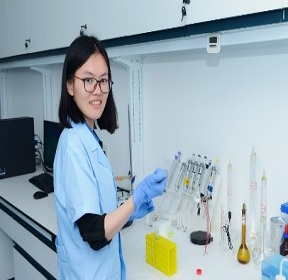
Liu Wang
ChinaTitle: Hue-change based lateral flow dipsticks for visually semi-quantitative detection of food pathogens
Abstract:
Rapid detection of food pathogens is of critical importance to ensure food safety. Lateral flow assay is one of the most widely and popular used methods for rapid detection. However, present lateral flow assays mainly depend on AuNPs as the signal reporters, making it hard for semi-quantitative detection by naked eyes. To realize visibly semi-quantitative detection, we have developed a hue change-based lateral flow assay. Two kinds of microspheres with red fluorescence emission and green fluorescence emission, respectively, are used as signal labels for the strip. The green, fluorescent microspheres are pre-fixed on the T line of the test strip. The red, fluorescent microspheres are pre-sprayed on the conjugated pad, and can be captured by the antibody on the T-line through antigen labeled ssDNA probe, changing the fluorescent emission of the T-line from green to red. Specific gene sequences from the target pathogens will activate CRISPR/Cas12a and lead to the trans-cleavage of antigen-labeled ssDNA, so that the red fluorescent microspheres cannot be captured on the T line. In this way, the T-line emits green fluorescence. The color change of the T line from green to red is closely related to the concentration of ssDNA, making it feasible for semi-quantitative detection. The strip has more sensitive visual discrimination capability than the AuNPs-based strip, without changing the positions of C line and T line. By combining the strip with recombinase polymerase amplification (RPA) and CRISPR/Cas12a, the method could detect as low as one copy of inv A gene from Salmonella. It also demonstrates the semi-quantitative detection capability between 0 ~ 4×103 CFU Salmonella. This detection method is simple to operate, free of sophisticated instruments, and extremely suitable for in-situ detection. Besides food pathogens, the method can be extended to the detection of food species for preventing food adulteration.
Biography:
Liu Wang is an associate researcher in the Institute of Agro-product Safety and Nutrition, Zhejiang Academy of Agricultural Sciences. She received her bachelor’s degree from Huazhong Agricultural University in 2012 and her Ph.D. from Zhejiang University in 2018. Her scientific interest is developing rapid and convenient methods for detection of food pathogens. Her research work has produced more than 40 journal papers and 6 authorized patents.

